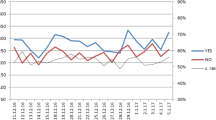Abstract
Reported barriers to participation in biospecimen banking include unwillingness to undergo blood-draw procedures and concerns about confidentiality breaches, privacy, and discrimination. The study identified key factors and influential perspectives to address these barriers and inform methods to improve recruitment and research participation among racially diverse community. A mixed-methods, community-based participatory research orientation was used to collect formative findings to develop a pilot intervention. Methods included nine key informant interviews, three focus groups (n = 26), and 64 community surveys. Findings showed: (1) increased concern of exploitation by pharmaceutical company sponsor; (2) varied perceptions about monetary compensation for research participation; and (3) willingness to participate in a biospecimen banking study by more than 30% of the people in the community survey. Research participation and biospecimen donation may be influenced by who is sponsoring a study. Monetary incentives for study participation may be more important for African American than White participants.
Similar content being viewed by others
Notes
Love Canal was an unfinished canal and land region in the Niagara Falls NY area that was used to dump an estimated 22,000 tons of mixed chemical and hazardous wastes from 1942 to 1953, then covered with dirt and declared safe. This land was sold in 1955 to construct an elementary school and housing development. Unusually heavy rain and snowfall in 1975 and 1976 caused the previously buried biohazardous chemicals and waste to permeate the soil and drinking water in the area, and in 1978 it was declared a threat by the New York Department of Health Commissioner. Families were evacuated, lawsuits were subsequently filed, and subsequent chromosome damage in residents was discovered.
References
National Institutes of Health. 2012. National Human Genome Research Institute: the National Human Genome Research Institute strategic plan for reducing health disparities. http://www.genome.gov/10001493. Accessed 06/20/2012
National Human Genome Research Institute. 2011. The cancer genome atlas. http://cancergenome.nih.gov/. Accessed 06/20/2011.
Murphy J, Scott J, Kaufman D, Geller G, LeRoy L, Hudson K (2009) Public perspectives on informed consent for biobanking. Am J Public Health 99:2128–2134
Secko DM, Preto N, Niemeyer S, Burgess MM (2009) Informed consent in biobank research: a deliberative approach to the debate. Social Science & Medicine 68:781–789
Beskow LM, Dean E (2008) Informed consent for biorepositories: assessing prospective participants’ understanding and opinions. Cancer Epidemiology Biomarkers Prevention 17:1440–1451
Johnsson L, Hansson MG, Eriksson S, Helgesson G (2008) Patients’ refusal to consent to storage and use of samples in Swedish biobanks: cross sectional study. BMJ 337:a345
Luque JS, Quinn GP, Montel-Ishino FA, Arevalo M, Bynum SA, Noel-Thomas S, Wells KJ, Gwede CK, Meade CD (2012) Formative research on perceptions of biobanking: what community members think. J Cancer Educ 27:91-99
Levitt M, Weldon S (2005) A well placed trust? Public perception of the governance of DNA databases. Critical Public Health 15:311–321
Wood F, Kowalczuk J, Elwyn G, Mitchell C, Gallacher J (2011) Achieving online consent to participation in large-scale gene-environment studies: a tangible destination. Journal of Medical Ethics 37:487–495
Wang SS, Fridinger F, Sheedy KM, Khoury MJ (2001) Public attitudes regarding the donation and storage of blood specimens for genetic research. Community Genetics 4:18–26
Sanner J, Frazier L (2007) Factors that influence the characteristics of genetic biobanks. J Nurs Scholarsh 39:25
Goldman, Roberta E, Caroline Kingdon, Jared Wasser, Melissa A. Clark, Robert Goldberg, George D. Papandonatos, Edward Hawrot, Gideon Koren (2008) Rhode Islanders’ attitudes towards the development of a statewide genetic biobank. Personalized Medicine 5:339-359
Slattery LN (2007) Assessing the perceptions of African Americans toward genetics and genetics research. PhD dissertation, University of Washington, 2000
Ambrosone CB, Nesline MK, Davis W (2006) Establishing a cancer center data bank and biorepository for multidisciplinary research. Cancer Epidemiol Biomarkers Prev 15:1575–1577
U.S. Census Bureau. 2010. Niagara Falls, New York. http://quickfacts.census.gov. Accessed 12/20/2011
U.S. Census Bureau. 2010. Buffalo, NY. http://quickfacts.census.gov/. Accessed 11/20 2010
Corbie-Smith G, Blumenthal C, Henderson G, Garrett J, Bussey-Jones J, Moloney M, Sandler RS, Lloyd SW, Dorrance J, Darter J (2008) Studying genetic research participants: lessons from the “learning about research in North Carolina” study. Cancer Epidemiol Biomarkers Prev 17:2019–2024
Gamito EJ, Linda Burhansstipanov, Krebs LU, Bemis L, Bradley A (2005) The use of an electronic audience response system for data collection. J Cancer Educ 20:80-86
Sudarsan NR, Jandorf L, Erwin DO (2011) Multi-site implementation of health education programs for Latinas. Journal of Community Health 36:193
State University of New York at Buffalo. Love canal collections. http://library.buffalo.edu/specialcollections/lovecanal/about/. Accessed 02/20/12
Acknowledgments
The authors would like to thank E. Cohen, P. Posey, O. Steed, and A. Primus of the Community Leadership Group in Niagara Falls, NY, and Detric Johnson, Paula Jones, Margaret Zuppa, and Mary Nesline for their assistance in this research and review of this article. This study was funded by Roswell Park Cancer Institute Alliance Foundation and NIH Partners in Research Program grant R03CA139946 from the National Cancer Institute. The Roswell Park Cancer Institute DataBank and Biorepository is a CCSG Shared Resource supported by P30CA016056-27. Marc T. Kiviniemi’s work on this project was supported by NIH grant K07CA106225. The content is solely the responsibility of the authors and does not necessarily represent the official views of the National Cancer Institute or the National Institutes of Health. Sections of this manuscript were presented as a poster, at the American Association for Cancer Research (AACR), Disparities Symposium, February 3–6, 2009, in Carefree, AZ, and as a podium presentation at the International Cancer Education Conference, September 8, 2011, in Buffalo, NY.
Conflict of Interest
The authors declare that they have no conflict of interest.
Author information
Authors and Affiliations
Corresponding author
Rights and permissions
About this article
Cite this article
Erwin, D.O., Moysich, K., Kiviniemi, M.T. et al. Community-Based Partnership to Identify Keys to Biospecimen Research Participation. J Canc Educ 28, 43–51 (2013). https://doi.org/10.1007/s13187-012-0421-5
Published:
Issue Date:
DOI: https://doi.org/10.1007/s13187-012-0421-5




